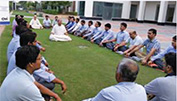Today’s corporate world is busy with measures of maximizing
profit and facing hostile competition but failing to add spiritual
values, it encounters numerous problems. Stress, improper time
management, inability to address conflict and so on brings complications
that ultimately result in unhappiness, sickness, and
even death. By unlocking the hidden potential which every individual
has everything can be put into use in a positive and healthy
way. Yes, this can be done by
introducing spiritual technology
in education, management
and work culture

ISKCON has instituted V-Serve
with a vision to provide
guidance to integrate ancient
spiritual wisdom and modern
material knowledge in ways
that allow everyone to fulfill the purpose of human life.
V-serve is a group of serious practitioners of best practices in
management, corporate professionalism, entrepreneurship and
spirituality. It offers a wide array of courses in the areas of stress
management, anger management, conflict resolution, art of
delegation, embracing change, mind awareness etc.,to suit the
training needs of the corporate sector.
Through different training modules they try to equip the trainees
with the capabilities to unlock the hidden potential within
to bring about a total transformation- a spiritual paradigm, thus
changing the quality of personal – professional – family and
social life.
V-serve embeds ethics and spiritual values into the workplace
with Life Style Management Techniques which brings a
Transformation in Consciousness. And that means increased
productivity, profitability, employee retention, interpersonal relationships,
team bonding, customer loyalty, role clarity, employee
engagement and thus brand reputation.
A brief about the Training Modules
RECONNECT
V-Serve conducts a refresher course where a snapshot of the modules is delivered to each specific batch.
|
It includes a recap, an action plan for HR and sharing of “new learnings”. The Vedic paradigm is of continuous learning.
Personal Management
Stress: Pschological definition, Social and economic costs, Symptoms, Causes- the CAUSE model, Lifestyle Management for Work life Balance, Overcoming Stress- the CURE NOW model, Stress Management : the Spiritual Paradigm, Meditation, Plugging into Higher Planes.
Anger: Behavioral definition, Cause of Anger- from the scriptures,
Styles of Anger Management, Handling anger towards colleagues, Handling Angry colleagues, Solutions- Physical, Mental, Spiritual, Anger Management- the Vedic Vision, Anger Management- The
Ideal Vedic Model.
Relationship Management
Conflict Resolution: Definition and Types of Conflict, Levels of
conflict, Personality Styles- Assertive, Aggressive and Passive, Personality Styles in the light of Modes of Material Nature from Bhagavad Gita, Sanitizing sentences, Reflective Listening, NICE
Model of Communication, True Ego vs False Ego, Glorifying Colleagues.
The Art of Delegation: Why and Why not? IDEALS Model of
Delegation, Delegation- of what and to whom? Supporting and monitoring others, Delegating to the qualified person, Working with the reluctant delegate, Delegation based on strength
INNER-SELF MANAGEMENT
Embracing Change: Concepts of change, Stages of inevitable
change, Learning to embrace change, The Cranky Quiz- how resistant
are you to change? Spiritual attitude to change, Gita and the
psychology of change & giving benefit of the doubt.
Map: Mental Awareness Program: What is the Mind? Human vs
Wild Mind, States of Mind- as per the science of Yoga, Mind vs Intelligence, Are we the Mind? How the Mind degrades us, The Art of Mind Control, Meditation for Mind Control, Mantra for Peace of Mind, Developing Maturity by developing a Mature Mind.
More Servings
Team Work, Effective Communication, Wellness, Morality, Ethical
Leadership, Work Life Balance.
|
These will be 3 hour sessions and will also involve extensive personal interaction with the Trainer. The training methodology includes Videos, Group discussions, case studies, role plays, assignments and action planning for follow ups and will be for a batch size of 20.
Benefits of Training with
V-Serve
Flexibilty
- Training tailored to meet the needs with flexible scheduling options.
- Training delivered at the location of the organization.
Affordability
- TCustomized Training modules Competitively priced to suit the budget of the company.
Experience
- Experienced training consultants will work with the organization to determine a training program that is just right for the company.
- The training team is experienced in business and industry issues and approach the training program holistically.
Impact
- Positive impact on the business by creating a
positive impact on the employees
- Equip employees to work under pressure
with greater calmness and clarity of mind
V-Serve is located at Hare Krishna Hill, Sant Nagar Main Road, East of Kailash, New Delhi -110065, India.
For more details write to
info@v-serve.biz.

|